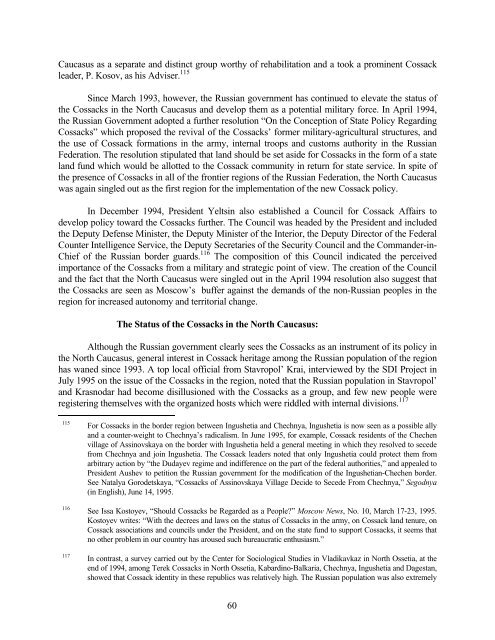RUSSIA'S TINDERBOX - Belfer Center for Science and International ...
RUSSIA'S TINDERBOX - Belfer Center for Science and International ...
RUSSIA'S TINDERBOX - Belfer Center for Science and International ...
You also want an ePaper? Increase the reach of your titles
YUMPU automatically turns print PDFs into web optimized ePapers that Google loves.
Caucasus as a separate <strong>and</strong> distinct group worthy of rehabilitation <strong>and</strong> a took a prominent Cossack<br />
leader, P. Kosov, as his Adviser. 115<br />
Since March 1993, however, the Russian government has continued to elevate the status of<br />
the Cossacks in the North Caucasus <strong>and</strong> develop them as a potential military <strong>for</strong>ce. In April 1994,<br />
the Russian Government adopted a further resolution “On the Conception of State Policy Regarding<br />
Cossacks” which proposed the revival of the Cossacks’ <strong>for</strong>mer military-agricultural structures, <strong>and</strong><br />
the use of Cossack <strong>for</strong>mations in the army, internal troops <strong>and</strong> customs authority in the Russian<br />
Federation. The resolution stipulated that l<strong>and</strong> should be set aside <strong>for</strong> Cossacks in the <strong>for</strong>m of a state<br />
l<strong>and</strong> fund which would be allotted to the Cossack community in return <strong>for</strong> state service. In spite of<br />
the presence of Cossacks in all of the frontier regions of the Russian Federation, the North Caucasus<br />
was again singled out as the first region <strong>for</strong> the implementation of the new Cossack policy.<br />
In December 1994, President Yeltsin also established a Council <strong>for</strong> Cossack Affairs to<br />
develop policy toward the Cossacks further. The Council was headed by the President <strong>and</strong> included<br />
the Deputy Defense Minister, the Deputy Minister of the Interior, the Deputy Director of the Federal<br />
Counter Intelligence Service, the Deputy Secretaries of the Security Council <strong>and</strong> the Comm<strong>and</strong>er-in-<br />
Chief of the Russian border guards. 116 The composition of this Council indicated the perceived<br />
importance of the Cossacks from a military <strong>and</strong> strategic point of view. The creation of the Council<br />
<strong>and</strong> the fact that the North Caucasus were singled out in the April 1994 resolution also suggest that<br />
the Cossacks are seen as Moscow’s buffer against the dem<strong>and</strong>s of the non-Russian peoples in the<br />
region <strong>for</strong> increased autonomy <strong>and</strong> territorial change.<br />
The Status of the Cossacks in the North Caucasus:<br />
Although the Russian government clearly sees the Cossacks as an instrument of its policy in<br />
the North Caucasus, general interest in Cossack heritage among the Russian population of the region<br />
has waned since 1993. A top local official from Stavropol’ Krai, interviewed by the SDI Project in<br />
July 1995 on the issue of the Cossacks in the region, noted that the Russian population in Stavropol’<br />
<strong>and</strong> Krasnodar had become disillusioned with the Cossacks as a group, <strong>and</strong> few new people were<br />
registering themselves with the organized hosts which were riddled with internal divisions. 117<br />
115 For Cossacks in the border region between Ingushetia <strong>and</strong> Chechnya, Ingushetia is now seen as a possible ally<br />
<strong>and</strong> a counter-weight to Chechnya’s radicalism. In June 1995, <strong>for</strong> example, Cossack residents of the Chechen<br />
village of Assinovskaya on the border with Ingushetia held a general meeting in which they resolved to secede<br />
from Chechnya <strong>and</strong> join Ingushetia. The Cossack leaders noted that only Ingushetia could protect them from<br />
arbitrary action by “the Dudayev regime <strong>and</strong> indifference on the part of the federal authorities,” <strong>and</strong> appealed to<br />
President Aushev to petition the Russian government <strong>for</strong> the modification of the Ingushetian-Chechen border.<br />
See Natalya Gorodetskaya, “Cossacks of Assinovskaya Village Decide to Secede From Chechnya,” Segodnya<br />
(in English), June 14, 1995.<br />
116 See Issa Kostoyev, “Should Cossacks be Regarded as a People?” Moscow News, No. 10, March 17-23, 1995.<br />
Kostoyev writes: “With the decrees <strong>and</strong> laws on the status of Cossacks in the army, on Cossack l<strong>and</strong> tenure, on<br />
Cossack associations <strong>and</strong> councils under the President, <strong>and</strong> on the state fund to support Cossacks, it seems that<br />
no other problem in our country has aroused such bureaucratic enthusiasm.”<br />
117 In contrast, a survey carried out by the <strong>Center</strong> <strong>for</strong> Sociological Studies in Vladikavkaz in North Ossetia, at the<br />
end of 1994, among Terek Cossacks in North Ossetia, Kabardino-Balkaria, Chechnya, Ingushetia <strong>and</strong> Dagestan,<br />
showed that Cossack identity in these republics was relatively high. The Russian population was also extremely<br />
60
















